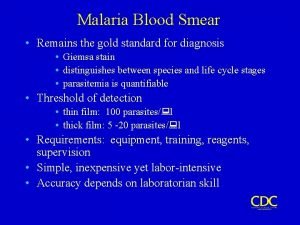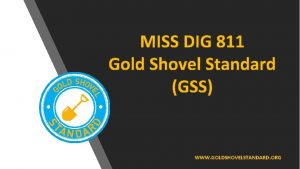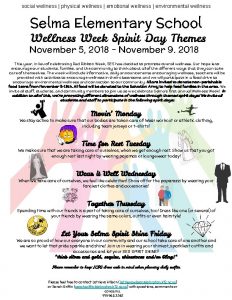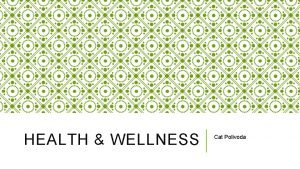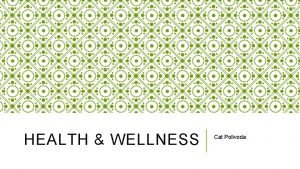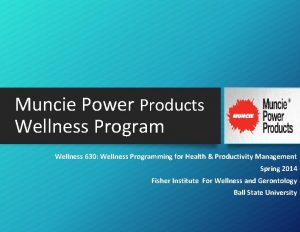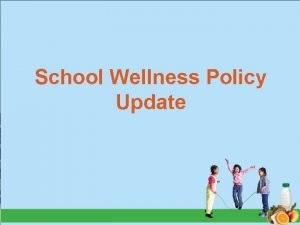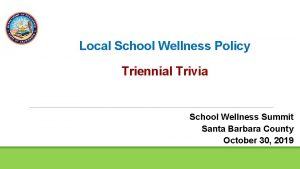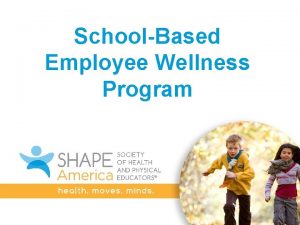Making the Case for Gold Standard School Wellness





































- Slides: 37

Making the Case for Gold Standard School Wellness Policies Creating a Healthy Future for Alaska Lauren Kelsey School Grants Manager Alaska Obesity Prevention & Control Program Ellen Hackenmueller Program Specialist Department of Education Child Nutrition Programs Alaska School Health & Wellness Institute October 15, 2014

Today’s Session �Key arguments to make the case for strong wellness policies �Overview of the State of Alaska Gold Standard School Wellness Policy �Role of EED Child Nutrition Programs on compliance �Resources available to support your work �Frequently Asked Questions / Q & A

Wellness policies promote life-long wellness behaviors, and link healthy nutrition and exercise to students' overall physical well-being

Now is the Time to Review Your School Wellness Policy � New regulations, related to wellness policy implementation requirements and nutrition standards for foods sold at schools, came into effect in fall 2014. � Adoption of and adherence to school wellness policies is part of the National School Breakfast and Lunch Program.

Childhood obesity is the predominant public health threat facing Alaska today. Too many of our kids are overweight or obese. They do not get enough physical activity. They drink too many sugary beverages. And they are suffering the consequences. If we don’t act now, our kids could be the first generation that has a shorter life expectancy than their parents.

Healthy, Successful Students Healthy eating behaviors and regular physical activity are essential for students to achieve their full academic and life potential. School districts recognize that they have a responsibility to provide a healthy learning environment by supporting wellness, good nutrition, and regular physical activity.

The Health and Achievement Link � The academic success of Alaska’s youth is strongly linked with their health. � Health-related factors such as hunger, physical and emotional abuse, and chronic illness can lead to poor school performance. � Physical inactivity is consistently linked to poor grades and test scores and lower educational attainment.

We can do this! We need to create an Alaska where every child lives, learns and plays in an environment filled with healthy choices. We can do this if we work together.

School Wellness Policies: Federal Requirements At a minimum, a local school wellness policy must— 1. Include goals for nutrition promotion and education, physical activity, and other school-based wellness activities 2. Include nutrition guidelines to promote student health and reduce childhood obesity 3. Permit stakeholders (e. g. , parents, students, school administrators and the general public) to participate in the development, implementation, and review and update of the local wellness policy

School Wellness Policies: Federal Requirements (continued) 4. Inform and update the public (including parents, students, and others in the community) about the content and implementation of local wellness policies 5. Be measured periodically with assessment results available to the public

Model Policy for Alaska The Alaska Obesity Prevention and Control Program and the Alaska Department of Education and Early Development worked together to craft a model policy that meets all the federal requirements: http: //dhss. alaska. gov/dph/Chronic/Documents/Obesity/pubs/ Similar policy is available for members of the Association of Alaska School Boards.

Key Elements of Gold Standard School Wellness policy

Key Element: Nutrition Guidelines �All foods sold at school, during the school day (from midnight to 30 minutes after the last class period ends) must meet nutritional guidelines for healthy foods - this includes food and drinks sold in vending machines and at school stores �No exemptions to nutritional guidelines for foods SOLD to students �Unhealthy foods will not be advertised or “marketed” at schools

Key Element: Nutrition-related Goals � Nutrition Education Standards based nutrition education Ø Integrated into curricula (i. e. health or cooking classes) Ø Educational links with school environment � Nutrition Promotion Ø Team Nutrition Ø Healthier. US School Challenge Ø School Gardens Ø Staff modeling healthy habits Ø

Key Element: PE Schools will provide physical education to all elementary, middle and high school students at the following levels: Grade Level Minutes per Week Elementary School 150 Middle School 225 High School 225, at least one year; required for all students

Key Element: Physical Activity � Elementary and middle school students will be provided with at least 45 minutes each day of physical activity, not including time spent in physical education � Physical activity can be before, during or after school and can include classroom based physical activity. � Elementary students should receive 20 minutes of active structured recess each day � Opportunities for recess or other physical activity should not be used as a form of behavior management

Key Element: Other Wellness Goals �Other Wellness Goals Ø Lunchroom environment (Smarter Lunchroom Techniques) Ø Health fairs Ø Before/After School Program Ø Safe Routes to School

Key Element: Stakeholder Participation �Requires stakeholder participation throughout the entire process of creating a wellness policy— drafting, implementing, assessment, revising �Represents a wide variety of interests: Ø Ø Ø Parents Students Teachers School health professionals Administrators Community members

Key Element: Measuring Implementation �Requires periodic assessment of the wellness policy Ø Ø Ø School compliance Comparison to model wellness policy Progress toward goals �Clear plan for measuring implementation success �Designated official to monitor compliance

Key Element: Communication and Reporting �The District will develop an annual report about compliance with the policy and progress toward meeting the goals �The report will be made available to students, parents, and the community

Child Nutrition Program Review of Policy �Part of the National School Lunch Program administrative review process �Child Nutrition Programs IS responsible for the following: Ø Ø Ensuring that the policy contains the required elements Ensuring district/agency has taken the required steps regarding implementation, transparency, public input and availability. �Child Nutrition Programs is NOT responsible for evaluating the quality of the district’s wellness goals or policies.

Administrative Review Findings �If deficiencies are identified during a School Lunch Program Administrative Review: Ø District will be noncompliant with the local wellness policy evaluation Ø Department of Education Child Nutrition Program will provide technical assistance

Supporting Documentation Needed �Copy of the Local Wellness Policy (LWP) �Documentation that the policy has been made available to the public �Documentation of district’s efforts to review & update the local policy �Copy of district’s most recent assessment on the implementation of the policy

Frequently Asked Questions

Lunches Brought from Home Q. Will students’ homepacked lunches be subject to nutrition standards? A. No. Students homepacked lunches are not required to meet the federal nutrition standards.

Teachers’ Snacks Q. What snacks are teachers allowed to consume at school? A. The nutritional standards apply to food sold and served to students. Staff are not required to follow these guidelines but are encouraged to model healthy behaviors.

Classroom Parties Q. Are classroom parties held in celebration of cultural holidays required to meet the nutrition standards? A. Schools may allow serving of culturally significant food when served free of charge to students as part of an educational activity.

What can we sell? Q. Does this mean we’re going to be limited to selling carrot sticks and hardboiled eggs? A. No. The Food Industry is quickly adapting to these standards. There a variety of products that meet the federal nutrition standards.

Smart Snacks Implementation Q. How do I know if the items we sell in our school store and vending machines are permitted? A. The Alliance for a Healthier Generation has some great online tools for assessing your competitive foods. Check them out online at: https: //www. healthiergeneration. org/take_action/schools /snacks_and_ beverages/

Exemptions to Nutrition Standards Q. Are there exemptions to the nutrition standards for fundraisers at school, during school. A. No. In Alaska, there are no exemptions from the nutritional standards for food sold to students at school, during the school day (from midnight to 30 minutes after the close of the last instructional period).

PE Pass/Fail Option Q. Why are substitutions and pass/fail options not allowed for physical education? A. Quality PE is important to equip students with the knowledge and skills to safely maintain physical fitness through a variety of activities and practices. Allowing substitutions for sports or dance defeats that purpose. Allowing pass/fail options devalues physical education as an important subject in the school curriculum.

PE Minutes Q. Our schedule for next year is already approved and does not have the recommended amount of minutes. A. Incremental policy steps can be considered. Guidance for developing incremental approaches to complying with national PE standards can be found at: http: //redegroup. co/opcp-wellness-policy

Above and beyond Q. Can our school have go beyond what is in the wellness policy? A. Yes. Districts may have practices that exceed the requirements at a federal level and individual schools may have practices that exceed the standards of the overall district wellness policy

Timing/Deadlines Q. What is the deadline for updating our wellness policy? A. Compliance with the new regulations on all foods sold during the school day (“Smart Snacks in School”) began July 1, 2014. There is no specific due date for updating the policy. Written policies and annual implementation reports will be assessed at the next regularly scheduled NSLP administrative review.

Resources available for you �Awesome Gold Standard Policy, plus sample language for incremental steps �This slide deck, including ‘customizable’ slides for highlighting who is in your wellness team, local priorities, and suggestions for improvement �“I Support” Stickers �Additional materials to be developed �Technical Assistance via phone or email

For More Information Contact Ellen Hackenmueller Program Specialist State of Alaska Child Nutrition Programs, Department of Education Phone: 907 -465 -8719 Fax: 907 -465 -8910 Email: ellen. hackenmueller@alaska. gov Lauren Kelsey, MPH School Grants Manager State of Alaska Obesity Prevention and Control Program, Phone 907 -269 -8165 Fax 907 -269 -5446 E-mail lauren. kelsey@alaska. gov

Any Additional Questions
 Best case worst case average case
Best case worst case average case Making wellness a lifestyle
Making wellness a lifestyle Glennan building cwru
Glennan building cwru Gold standard malaria
Gold standard malaria Gold standard
Gold standard Gold standard study
Gold standard study Gold standard removed
Gold standard removed Gold shovel certification
Gold shovel certification Gold standard 1921
Gold standard 1921 Gilbane gold
Gilbane gold What is inferring
What is inferring War making and state making as organized crime summary
War making and state making as organized crime summary Kontinuitetshantering i praktiken
Kontinuitetshantering i praktiken Typiska novell drag
Typiska novell drag Nationell inriktning för artificiell intelligens
Nationell inriktning för artificiell intelligens Vad står k.r.å.k.a.n för
Vad står k.r.å.k.a.n för Varför kallas perioden 1918-1939 för mellankrigstiden
Varför kallas perioden 1918-1939 för mellankrigstiden En lathund för arbete med kontinuitetshantering
En lathund för arbete med kontinuitetshantering Kassaregister ideell förening
Kassaregister ideell förening Tidbok
Tidbok A gastrica
A gastrica Densitet vatten
Densitet vatten Datorkunskap för nybörjare
Datorkunskap för nybörjare Tack för att ni lyssnade bild
Tack för att ni lyssnade bild Mall debattartikel
Mall debattartikel Delegerande ledarstil
Delegerande ledarstil Nyckelkompetenser för livslångt lärande
Nyckelkompetenser för livslångt lärande Påbyggnader för flakfordon
Påbyggnader för flakfordon Arkimedes princip formel
Arkimedes princip formel Publik sektor
Publik sektor Jag har nigit för nymånens skära text
Jag har nigit för nymånens skära text Presentera för publik crossboss
Presentera för publik crossboss Vad är ett minoritetsspråk
Vad är ett minoritetsspråk Vem räknas som jude
Vem räknas som jude Klassificeringsstruktur för kommunala verksamheter
Klassificeringsstruktur för kommunala verksamheter Mjälthilus
Mjälthilus Bästa kameran för astrofoto
Bästa kameran för astrofoto Centrum för kunskap och säkerhet
Centrum för kunskap och säkerhet



